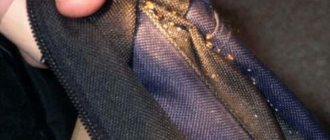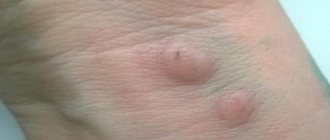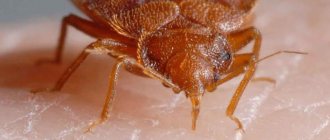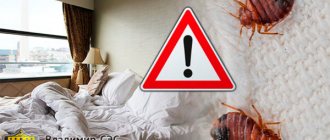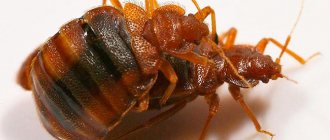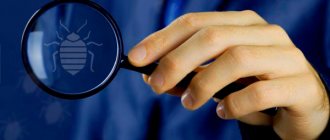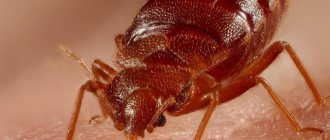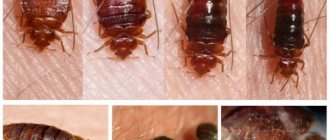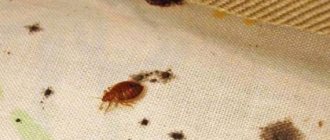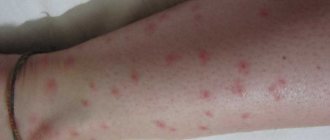With the appearance of bed bugs in a house, the life of its inhabitants does not change for the better: poor sleep, allergic reactions on the skin and poor health constantly accompany all residents of an infested apartment. Since the size of the parasites is very small, only indirect signs indicate their presence. After all, they lead a predominantly nocturnal, secretive lifestyle, becoming active exclusively at night. Where to look for bloodsuckers? Where in the home can you find the largest concentration of them? Do they live in bedding and can bedbugs live in pillows?
Where do bedbugs most often settle?
For a comfortable existence, insects need food, warmth and the absence of sunlight. Bed bugs establish their colonies behind baseboards and under parquet boards, in rosettes and cracks in plaster, behind wallpaper and wall hangings. But most often they nest in beds and under mattresses, where they are attracted by the smell of humans and the ability to easily obtain food at night.
At the same time, insects almost never live in pillows and blankets. This is due to the following reasons:
- Both synthetic and natural fillers usually have a smooth glossy finish and a heterogeneous structure. In addition, they are not evenly placed inside the pillow or blanket. This surface prevents bedbugs from moving at their usual speed, which makes them vulnerable.
- The thick fabric from which the bedding is made prevents insects from getting in and out.
- Porous filling, pressure applied to the pillow, and regular movement and turning of the blanket prevent bedbugs from laying eggs.
In addition, by tossing and turning in his sleep, a person can crush an insect. Therefore, pillows and blankets rarely become permanent habitats for parasites.
Why bedbugs don't live in pillows
Bed bugs get into pillows by accident. There are a number of reasons why they don't like living there.
- it is uncomfortable for them to hold onto the filler with their paws;
- there is constant pressure on the pillow, it is turned over, twisted, moved, but bedbugs love peace;
- It is inconvenient for insects to lay eggs in the litter.
For the same reasons, they do not like to live in blankets and inside mattresses. Most often, they settle outside, looking for small gaps in which it is convenient to hide a flat body.
It doesn’t really matter what filler is used in pastel accessories. It can be feathers, horsehair, padding polyester or buckwheat husks. Bedbugs feed only on blood, so the components of the filler are not important for them. And they live only where it is convenient to move around and lay eggs.
Although bedbugs do not live in pillows, they can crawl in there for a while.
During the day, insects are difficult to see because they do not like sunlight. But if you turn on the lamp sharply at night, you may notice a dark figure on the sheet, duvet cover or pillowcase. They crawl closer to their prey, and at this time they become most vulnerable.
Bedbugs especially often crawl onto the pillows of sleeping children. Children's skin is thin and delicate, it is easy to bite through, and if there are bedbugs in the house, then the child can find bite marks on the neck or head in the area of the temples and forehead. They look like reddish swellings and are very itchy.
In what cases do bedbugs infest bedding?
Despite the fact that insects look for quiet places for shelter that guarantee protection for them and their future offspring, pillows and blankets cannot be considered completely safe. Bedbugs are found in beds:
- with a high number of insects in the room;
- in case of rare change of bed linen;
- when there are holes and slits in the pillows;
- if bedbugs are in danger (they crawl under bedding).
Insects sometimes hide in the side seams of pillows and folds of blankets. Traces of their presence are found inside pillowcases and duvet covers, on the outside of the bedside. In this regard, when an apartment is infested with bedbugs, bedding must be treated along with other places where parasites frequently accumulate.
How to find bedbugs in a mattress
It is difficult to detect the true location of bedbugs, since insignificant dimensions are not detected by the naked human eye.
In addition, when a stranger appears in the room, insects tend to hide, crawling deep into the mattress, carpet or any other hard-to-reach place. There are a number of signs, the detection of which is not recommended to be ignored. If bedbugs begin to live in the mattress, a characteristic smell will appear, cloying and unpleasant. First of all, the seams of the sleeping product are inspected. During the molting process, bedbugs shed scales, which can be either transparent or light-colored. It is at the seams that this is found. Yellow spots on the surface of the sleeping area also indicate the presence of foreigners in the bed or mattress. During sleep, a person may be haunted by the feeling that someone is crawling on the skin. The next morning, these places are covered with wounds and a red rash, which indicates numerous bites. The waste products of bedbugs look like poppy seeds, which can be seen on the surface of a snow-white mattress or sheet.
The main signs of bedbugs:
- shed scales;
- feces;
- yellowish or brown spots on the sleeping area;
- characteristic smell;
- wounds on the body.
Smell
The bed or its individual elements will begin to emit an unpleasant aroma that vaguely resembles old cognac, brandy or sour jam. The smell does not come from insects, but from feces and scales, which parasites get rid of. At first, the smell will not be strong, and many believe that it is associated with dirty laundry or spoiled food in the room. Fragrances, frequent airing and intensive cleaning will not correct the situation, and valuable time will be lost.
Traces of stay
Many people wonder whether bedbugs can live inside the mattress itself.
The answer is obvious - they can. Insects lead a lifestyle hidden from human eyes, preferably nocturnal. With the arrival of darkness, pests crawl out of their secluded corners and go in search of food. Insect bites do not pose a health hazard, but the puncture site on the skin will turn red and begin to itch. If there are complications, painful blisters and a rash will appear at the site of the bite. Near one puncture you can find several more. This is due to the fact that the pest’s proboscis is small, which forces the blood-sucking animal to constantly move around the person in search of a new and better source of blood. To detect uninvited guests you will need:
- Ventilate the room and find the source of the unpleasant odor, if any.
- After a bite, the insect loses mobility for some time, which allows a person to unknowingly crush it by turning over in his sleep. This will be indicated by small red spots on the bed linen.
- Growing out of the old skin, the insect sheds the old one, which can be found on the folds of the bedding and the seams of the mattress.
- Black crumbs indicate the presence of excrement left by bedbugs.
- Bites on the skin appear as “paths”.
- Eggs are found on folds, folds and crevices. A bright lamp is used for searching.
Night search
When fighting bed bugs, it should be taken into account that pests are nocturnal. In essence, insects behave like people who want to eat in the middle of the night. The only difference is that they do not have a refrigerator, and the bugs prefer to feed directly from the “factory”. If you are absent for a long time, the culprits of the discomfort will get hungry and start looking for the person the moment he crosses the front door. Here, the time of day will not play a role, nor will the degree of illumination of the room.
How to get rid of insects in pillows
To combat parasites that have become infested in a pillow or blanket, you can use mechanical or chemical methods, and also try to get rid of insects using traditional methods:
- Mechanical treatment of a pillow involves cleaning or changing the filling and replacing the pillowcase. This technology is not suitable for pillows with synthetic filling and is only used for products with a feather or down base.
- With the chemical method for removing bedbugs, the pillow inside and outside is treated with special aerosol or liquid agents (Dichlorvos, Forside, Dust), and then it is necessary to dry it in the sun.
- The most common folk methods of insect control include heat treatment and exposure of insects to low temperatures. In the first case, the product is cleaned with steam or washed at a temperature of at least 50°C. In the second, the pillow is placed in the freezer and kept there for at least four days.
You can reduce the risk of bedbugs appearing in bed with the help of dried herbs and decoctions prepared from them. Wormwood, chamomile and wild rosemary are considered especially effective in the fight against parasites.
Signs of bedbugs in a mattress
Finding out whether there are bedbugs in a mattress is not easy, but there are still telltale signs. The first thing you should pay attention to is bites on the skin. The spots after a bedbug bite are specific, large in size and itchy continuously. It is impossible to confuse them with the consequences of a person’s acquaintance with midges and mosquitoes. The proboscis of bedbugs living in covers and on mattresses are somewhat shorter, which leads to the need to make several punctures in search of blood. At the site of the bite, you can find black dots, which are the excrement of insects that immediately digest the food during feeding.
The main differences in bites:
- One spot on the skin will not do, as bedbugs are constantly moving in search of new food, leaving behind entire furrows of bites.
- Blood-sucking parasites do not seal the bite site, as a result of which the wound may bleed.
- Mosquitoes can only bite in the summer, but winter disturbances indicate the presence of bedbugs.
Also, a characteristic sign of the presence of bed bugs in a mattress is a specific smell, only vaguely reminiscent of cognac.
New mattress with bedbugs
Bed bugs in a mattress can be an unpleasant surprise, especially when it comes to using a new product.
Are pests able to travel long distances and enter the home directly from a store or warehouse? How do harmful insects enter the home:
- warehouse premises are rarely subjected to disinfestation, and are cleaned even less often, which causes the appearance of bedbugs in the warehouse;
- repair crews are working everywhere and it is quite possible that the insects were brought in by people who worked in unsanitary conditions at the previous facility;
- hostels and cheap hotels are considered breeding grounds for bedbugs, which can settle in a suitcase with clean things that will safely arrive home after a long trip;
- guests, even the most well-groomed ones, cannot guarantee that bedbugs will not enter the house through clothes or shoes;
- open windows on a hot day will help bedbugs climb from the basement or neighbor’s room into the apartment straight along the wall;
- old ventilation shafts can become a home for bedbugs, allowing insects to travel unhindered from apartment to apartment.
Locating the location of bedbugs is difficult because the insects are small in size and like to hide. They penetrate into the mattress through the seams. There are a number of signs by which you can understand that bedbugs have appeared in the mattress. An example is the specific aroma of pests, vaguely reminiscent of cognac or sour compote. To begin with, the seams of the soft product must be inspected. It is in such places that it is easier to detect the husk that remains after the insect has molted. Yellowish spots indicate the presence of foreign inhabitants in the mattress. The feeling that someone is crawling on your skin at night may not be a figment of the imagination, but a signal that the person is not alone in bed. During their life, bedbugs excrete excrement, which on a white surface looks like poppy seeds or coffee beans.
Old mattress and bedbugs from neighbors
It is not easy to completely get rid of such insects living in a residential area, so removing bedbugs from a residential mattress is problematic. The reproduction rate of pests is high, the bodies are small in size, shy, agile and nocturnal. Don’t forget about the ability to hide in the most inaccessible places that are difficult to clean. The fight against bed bugs must be carried out comprehensively. Otherwise, if danger arises, the insects will simply move to another room. Preventive measures are also recommended to be carried out every few months.
Treating only the bed on which bedbugs have been identified is not able to solve the problem entirely, since the insects are able to quickly find a new place to live. And after a week, the bedbugs will return to the checked place, when the signs of disinfection have passed.
It is much more difficult to solve the problem in multi-apartment buildings, where bedbugs quietly crawl from one family to another, through cracks in the floor, open windows and doorways. It will not be possible to completely fence off an apartment, and measures must be taken in relation to each apartment, which is problematic.
What to do if you find bedbugs in your bed
When identifying bedbugs in the bedroom, it is important to prevent the insects from spreading throughout the room. To prevent further spread of parasites, the following rules must be observed:
- pillows and blankets cannot be moved to other rooms without first packing them in hermetically sealed bags;
- Contaminated bed linen should not be placed in a shared laundry basket;
- pillows, blankets, and pillowcases and duvet covers removed from them must be washed separately from other items;
- Products that cannot be soaked and washed in hot water are recommended to be taken outside and thoroughly beaten, and then treated in any available way;
- Treated bedding can be brought into the room only after disinfestation.
To protect your bed from the appearance of parasites, it is important to dry pillows and blankets as often as possible, regularly wash and iron bedding, and also periodically check the places where bedbugs like to make their nests.
Furniture bugs - how to get rid of them?
Bedbugs quickly get used to chemicals, so finding a universal remedy for their destruction is almost impossible. Therefore, to get rid of bed bugs in an apartment yourself, you can use several simple methods:
- Temperature treatment. Parasites are killed by frost below -20 degrees and high temperatures above +40 degrees. Therefore, it is useful to take bedding and small furniture outside for 2–4 hours in frosty and hot weather. You can also use a household steam generator.
- Quartzization. Before treating the room and things with an ultraviolet lamp, you must open the cabinet doors, open the sofas, and place bedding under the lamp.
Modern chemicals
In stores you can buy modern means to combat bedbugs, before using which you need to prepare the room:
- take out or hide food in the refrigerator;
- pack dishes;
- After making sure that there are no bedbugs in clothes and children's toys, pack them in impenetrable bags;
- cover the aquariums tightly;
- remove pets, birds, people from the apartment.
The most effective and popular means for exterminating furniture bedbugs include:
- Delta Zone. Microencapsulated drug, the action of which leads to paralysis and death of parasites. Its active substance is the insecticide deltamethrin. The main advantage of this remedy is that its effect lasts for several months.
- Pyrethrum. The drug contains a natural component that is obtained from chamomile flowers. Therefore, the insecticide is completely harmless to people and pets. Available in aerosol or powder form.
- Combat Superspray. The drug, which contains cyphenothrin and imiprotrin, paralyzes bedbugs and leads to their death. It comes in the form of an aerosol and has a citrus scent.
- Executioner. The product contains the active substance fenthion. Its action paralyzes the nervous system of the parasite and leads to its death. The drug is available in liquid form. Before use, it must be diluted according to the instructions.
If you can’t get rid of furniture bugs on your own, you can call an insect removal service. Specialists will carry out disinfestation of the premises efficiently and quickly.
Do-it-yourself mattress treatment for bedbugs
If you decide to act on your own, then follow this algorithm:
- The first step is to remove all bedding from the bed, wash it at maximum temperature, and iron it.
- Visually inspect the mattress from all sides. If you don't notice anything, move on to the next step.
- In order to avoid the spread of parasites to different places in the room, barks, paintings and other interior items should be removed from it.
- Next, remove the mattress from the bed frame and carefully inspect all the stitching and all the seams on the mattress. If the mattress cover can be removed, feel free to remove it and wash it at maximum temperature. Don't forget to iron it.
- If there are no signs of parasite life, look inside the mattress; it is quite possible that they are hiding there.
- The entire mattress must be treated with insecticides on all sides and inside it. You can use Xulat Micro. It is important to observe all the precautions that are written on the packaging and strictly follow the instructions.
- It is also necessary to treat the entire occupied area of the room.
- If your mattress has served you for more than five years, then you don’t have to waste time on treating it and just get rid of it. He has already served his time.
In addition to treating your mattress for bedbugs yourself, there are several other ways to get rid of them.
How do bedbugs get into an apartment?
- Ventilation pipes . This is the most common option for bedbugs to escape through apartments. They move freely from one apartment to another.
- Window . In the summer, bedbugs can easily climb into your window through the basement (if you live on the first floor), or along the wall from a neighboring apartment.
- Guests . Without knowing it, guests may bring bedbugs on their clothes.
- Hotels . By staying at another hotel that has not been checked by you, you risk bringing a “gift” for your home in your suitcase.
- Workers . There have been many recorded cases where, during the repair process, workers brought bedbugs from one site to another.
- The shops . You bought a mattress and brought it home. Perhaps it is already infested with bedbugs, since the warehouse where they are stored is not ideally clean.
What are the dangers of bed bugs and ticks?
Ticks and bedbugs are parasites that feed on human blood. The size of bed ticks can vary from 2–8 millimeters, but unlike ordinary ones, they are quite difficult to detect, since there are no obvious bites.
Anyone can detect parasites such as bedbugs or ticks in bed linen or pillows
The sooner a tick is detected, the less harm it will cause to human health. If you have parasites living in your pillow, you may experience an allergic reaction. And subsequently this will lead to general malaise, fatigue, and nervousness. Performance will decrease.
The combination of these factors will negatively affect the psychological and physical state of the body.
